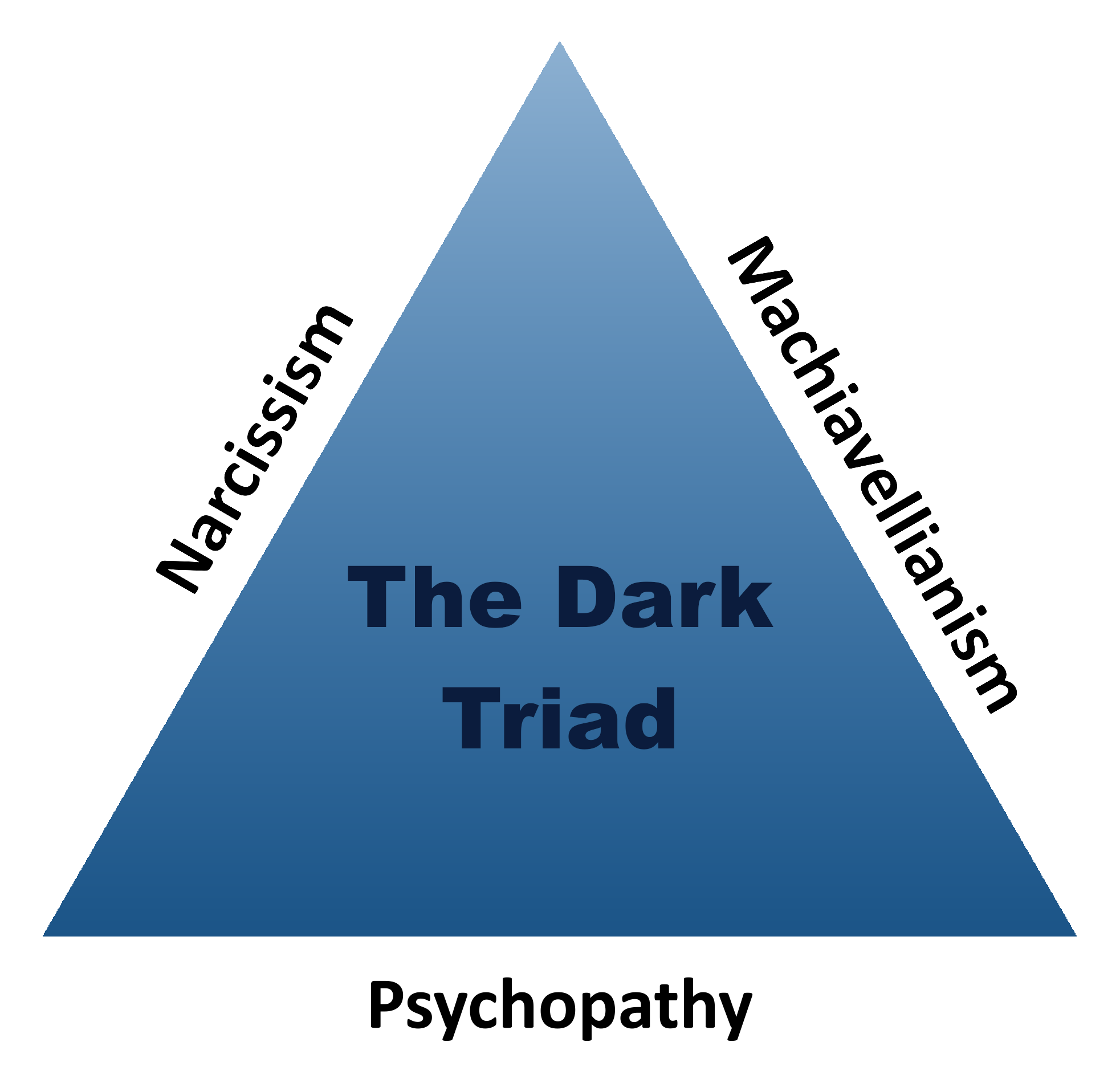|
Agreeableness
Agreeableness is the trait theory, personality trait of being kind, Sympathy, sympathetic, cooperative, warm, honest, straightforward, and considerate. In personality psychology, agreeableness is one of the Big Five personality traits, five major dimensions of personality structure, reflecting individual differences in cooperation. People who score high on measures of agreeableness are Empathy, empathetic and Altruism, self-sacrificing, while those with low agreeableness are prone to selfishness, insincerity, and zero-sum thinking. Those who score low on agreeableness may show dark triad tendencies, such as narcissism, narcissistic, Antisocial personality disorder, antisocial, and Manipulation (psychology), manipulative behavior. Agreeableness is a superordinate trait, meaning it is a grouping of personality sub-traits that cluster together statistically. Some lower-level traits, or Facet (psychology), facets, that are commonly grouped under agreeableness include Trust (social sci ... [...More Info...] [...Related Items...] OR: [Wikipedia] [Google] [Baidu] [Amazon] |
Big Five Personality Traits
In personality psychology and psychometrics, the Big 5 or five-factor model (FFM) is a widely-used Scientific theory, scientific model for describing how personality Trait theory, traits differ across people using five distinct Factor analysis, factors: * Openness to experience, ''openness'' (''O'') measures creativity, curiosity, and willingness to entertain new ideas. * ''conscientiousness'' (''C'') measures self-control, diligence, and attention to detail. * Extraversion and introversion, ''extraversion'' (''E'') measures boldness, Surgency, energy, and social interactivity. * ''amicability'' or ''agreeableness'' (''A'') measures kindness, helpfulness, and willingness to cooperate. * ''neuroticism'' (''N'') measures depression, irritability, and moodiness. These traits are not black and white; each one is a spectrum, with personality varying Continuous or discrete variable, continuously across each of these dimensions (unlike in the Myers–Briggs Type Indicator, MBTI inventory ... [...More Info...] [...Related Items...] OR: [Wikipedia] [Google] [Baidu] [Amazon] |
Facet (psychology)
In psychology, a facet is a specific and unique aspect of a broader personality trait. Both the concept and the term "facet" were introduced by Paul Costa and Robert McCrae in the first edition of the NEO-Personality Inventory (NEO-PI) Manual. Facets were originally elaborated only for the neuroticism, openness to experience, and extraversion traits; Costa and McCrae introduced facet scales for the agreeableness and conscientiousness traits in the Revised NEO-PI (NEO PI-R). Each of the Big Five personality traits in the five factor model contains six facets, each of which is measured with a separate scale. The use of facets and facet scales has since expanded beyond the NEO PI-R, with alternative facet and domain structures derived from other models of personality. Examples include the HEXACO model of personality structure, psycholexical studies, circumplex models (e.g., Goldberg's Abridged Big-Five Dimensional Circumplex), the Multidimensional Personality Questionnaire (MPQ), ... [...More Info...] [...Related Items...] OR: [Wikipedia] [Google] [Baidu] [Amazon] |
Dark Triad
The dark triad is a psychological theory of personality, first published by Delroy L. Paulhus and Kevin M. Williams in 2002, that describes three notably offensive, but non-pathological personality types: Machiavellianism, sub-clinical narcissism, and sub-clinical psychopathy. Each of these personality types is called '' dark'' because each is considered to contain malevolent qualities. All three dark triad traits are conceptually distinct although empirical evidence shows them to be overlapping. They are associated with a callous–manipulative interpersonal style. * Narcissism is characterized by grandiosity, pride, egotism, and a lack of empathy. * Machiavellianism is characterized by manipulativeness, indifference to morality, lack of empathy, and a calculated focus on self-interest. * Psychopathy is characterized by continuous antisocial behavior, impulsivity, selfishness, callous and unemotional traits (CU), and remorselessness. High scores in these traits have be ... [...More Info...] [...Related Items...] OR: [Wikipedia] [Google] [Baidu] [Amazon] |
Trait Theory
In psychology, trait theory (also called dispositional theory) is an approach to the study of human personality psychology, personality. Trait theorists are primarily interested in the measurement of ''traits'', which can be defined as habitual patterns of behavior, thought, and emotion. According to this perspective, traits are aspects of personality that are relatively stable over time, differ across individuals (e.g. some people are outgoing whereas others are not), are relatively consistent over situations, and influence behaviour. Traits are in contrast to Mental state, states, which are more transitory dispositions. Traits such as Extraversion and introversion, extraversion vs. introversion are measured on a spectrum, with each person placed somewhere along it. Trait theory suggests that some natural behaviours may give someone an advantage in a position of leadership. There are two approaches to define traits: as internal causal properties or as purely descriptive summaries ... [...More Info...] [...Related Items...] OR: [Wikipedia] [Google] [Baidu] [Amazon] |
Personality Psychology
Personality psychology is a branch of psychology that examines personality and its variation among individuals. It aims to show how people are individually different due to psychological forces. Its areas of focus include: * Describing what personality is * Documenting how personalities develop * Explaining the mental processes of personality and how they affect functioning * Providing a framework for understanding Individual, individuals "Personality" is a dynamic and organized set of characteristics possessed by an individual that uniquely influences their environment, cognition, emotions, motivations, and Behavioural sciences, behaviors in various situations. The word ''personality'' originates from the Latin ''persona'', which means "mask". Personality also pertains to the pattern of thoughts, feelings, Adjustment (psychology), social adjustments, and behaviors persistently exhibited over time that strongly influences one's expectations, Self-concept, self-perceptions, Valu ... [...More Info...] [...Related Items...] OR: [Wikipedia] [Google] [Baidu] [Amazon] |
Empathy
Empathy is generally described as the ability to take on another person's perspective, to understand, feel, and possibly share and respond to their experience. There are more (sometimes conflicting) definitions of empathy that include but are not limited to social, cognitive, and emotional processes primarily concerned with understanding others. Often times, empathy is considered to be a broad term, and broken down into more specific concepts and types that include cognitive empathy, emotional (or affective) empathy, wiktionary:somatic#Etymology, somatic empathy, and spiritual empathy. Empathy is still a topic of research. The major areas of research include the development of empathy, the genetics and neuroscience of empathy, cross-species empathy, and the impairment of empathy. Some researchers have made efforts to quantify empathy through different methods, such as from questionnaires where participants can fill out and then be scored on their answers. The ability to imagin ... [...More Info...] [...Related Items...] OR: [Wikipedia] [Google] [Baidu] [Amazon] |
Raymond Cattell
Raymond Bernard Cattell (20 March 1905 – 2 February 1998) was a British-American psychologist, known for his psychometric research into intrapersonal psychological structure.Gillis, J. (2014). ''Psychology's Secret Genius: The Lives and Works of Raymond B. Cattell''. Amazon Kindle Edition. His work also explored the basic dimensions of personality and temperament, the range of cognitive abilities, the dynamic dimensions of motivation and emotion, the clinical dimensions of abnormal personality, patterns of group syntality and social behavior, applications of personality research to psychotherapy and learning theory,Cattell, R. B. (1987). ''Psychotherapy by Structured Learning Theory''. New York: Springer. predictors of creativity and achievement, and many multivariate research methodsCattell, R. B. (1966). (Ed.), ''Handbook of Multivariate Experimental Psychology''. Chicago, IL: Rand McNally. including the refinement of factor analytic methods for exploring and measuring these ... [...More Info...] [...Related Items...] OR: [Wikipedia] [Google] [Baidu] [Amazon] |
Humility
Humility is the quality of being humble. The Oxford Dictionary, in its 1998 edition, describes humility as a low self-regard and sense of unworthiness. However, humility involves having an accurate opinion of oneself and expressing oneself modestly as situations demand, with clear goal orientation, openness, broad-mindedness, and a non-imposing mentality. In a religious context, humility can mean a recognition of self about a deity (i.e. God) and subsequent submission to that deity as a religious member. Outside of a religious context, humility is defined as being "unselved"—liberated from the consciousness of self—a form of temperance that is neither having pride (or haughtiness) nor indulging in self-deprecation. Humility refers to a proper sense of self-regard. In contrast, humiliation involves the external imposition of shame on a person. Humility may be misinterpreted as the capacity to endure humiliation through self-denigration. This misconception arises from the co ... [...More Info...] [...Related Items...] OR: [Wikipedia] [Google] [Baidu] [Amazon] |
Sentimentality
Sentimentality originally indicated the reliance on feelings as a guide to truth, but in current usage the term commonly connotes a reliance on shallow, uncomplicated emotions at the expense of reason. Sentimentalism in philosophy is a view in meta-ethics according to which morality is somehow grounded in moral sentiments or emotions. Sentimentalism in literature refers to techniques a writer employs to induce a tender emotional response disproportionate to the situation at hand (and thus to substitute heightened and generally uncritical feeling for normal ethical and intellectual judgments). The term may also characterize the tendency of some readers to invest strong emotions in trite or conventional fictional situations. "A sentimentalist", Oscar Wilde wrote, "is one who desires to have the luxury of an emotion without paying for it." In James Joyce's '' Ulysses'', Stephen Dedalus sends Buck Mulligan a telegram that reads "The sentimentalist is he who would enjoy without in ... [...More Info...] [...Related Items...] OR: [Wikipedia] [Google] [Baidu] [Amazon] |
Gordon Allport
Gordon William Allport (November 11, 1897 – October 9, 1967) was an American psychologist. Allport was one of the first psychologists to focus on the study of the personality, and is often referred to as one of the founding figures of personality psychology. He contributed to the formation of values scales and rejected both a psychoanalytic approach to personality, which he thought often was too deeply interpretive, and a behavioral approach, which he thought did not provide deep enough interpretations from their data. Instead of these popular approaches, he developed an eclectic theory based on traits. He emphasized the uniqueness of each individual, and the importance of the present context, as opposed to history, for understanding the personality. Allport had a profound and lasting influence on the field of psychology, even though his work is cited much less often than that of other well-known figures. Part of his influence stemmed from his knack for exploring and broadly c ... [...More Info...] [...Related Items...] OR: [Wikipedia] [Google] [Baidu] [Amazon] |
16 Personality Factors
The Sixteen Personality Factor Questionnaire (16PF) is a self-reported personality test developed over several decades of empirical research by Raymond B. Cattell, Maurice Tatsuoka and Herbert Eber. The 16PF provides a measure of personality and can also be used by psychologists, and other mental health professionals, as a clinical instrument to help diagnose psychiatric disorders, and help with prognosis and therapy planning. The 16PF can also provide information relevant to the clinical and counseling process, such as an individual's capacity for insight, self-esteem, cognitive style, internalization of standards, openness to change, capacity for empathy, level of interpersonal trust, quality of attachments, interpersonal needs, attitude toward authority, reaction toward dynamics of power, frustration tolerance, and coping style. Thus, the 16PF instrument provides clinicians with a normal-range measurement of anxiety, adjustment, emotional stability and behavioral problems. Cli ... [...More Info...] [...Related Items...] OR: [Wikipedia] [Google] [Baidu] [Amazon] |
Cluster Analysis
Cluster analysis or clustering is the data analyzing technique in which task of grouping a set of objects in such a way that objects in the same group (called a cluster) are more Similarity measure, similar (in some specific sense defined by the analyst) to each other than to those in other groups (clusters). It is a main task of exploratory data analysis, and a common technique for statistics, statistical data analysis, used in many fields, including pattern recognition, image analysis, information retrieval, bioinformatics, data compression, computer graphics and machine learning. Cluster analysis refers to a family of algorithms and tasks rather than one specific algorithm. It can be achieved by various algorithms that differ significantly in their understanding of what constitutes a cluster and how to efficiently find them. Popular notions of clusters include groups with small Distance function, distances between cluster members, dense areas of the data space, intervals or pa ... [...More Info...] [...Related Items...] OR: [Wikipedia] [Google] [Baidu] [Amazon] |



